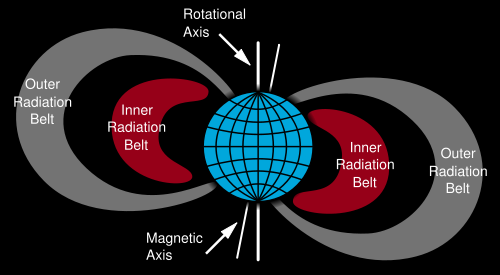



Mister Spock, Are Our Shields Up?
Previously we've talked about the Troposphere, the very bottom of the atmosphere that surrounds and protects our planet. Next we will look at some of the upper reaches of the atmosphere and how they protect and effect the Earth.
The Van Allen Radiation Belts
The outer-most layer of the atmosphere (greater than 500 kms), the Exosphere, is where the Van Allen radiation belts are found. These regions of invisible, but highly energetic, plasma — the fourth state of matter — are made up of positive and negatively charged particles bound to the Earth by its magnetic field as shown below.
Image provided by NASA (and therefore free of copyright).
Obtained from the WikiMedia Commons.
The inner belt is made up mainly of free protons and other positively charged ions, while the outer belt is mainly electrons. These highly energetic charged particles oscillate backwards and forwards between the Earth's two magnetic poles along the force lines of the magnetic field.
Why are they called radiation belts?
The belts are the direct result of the Earth having a magnetic field and are the remnants of heavy radiation from the Sun captured by the magnetic field. Electrons when travelling at speed are called Beta particles and the nuclei of Helium atoms (another part of the gamut of Solar radiation) are called Alpha particles. These particles, when moving at speed, are classed as radiation and are detectable with a Geiger Counter. In fact, the Van Allen Radiation belts were first detected when radiation counters were taken beyond low Earth orbit and even now spacecraft that are going to be travelling a significant distance from Earth need to be shielded from this radiation.
What should you take away from this?
The Van Allen Radiation belts are a consequence of the Earth having a magnetic field, without this magnetic field the Earth would be a much nastier place. For example, astronauts on the Moon and (hopefully one day) Mars will have to continually monitor the radiation from the Sun to avoid excessive radiation exposure because they won't have a magnetic field protecting them. If you are going to design your own planet then I suggest you give it a liquid core so that it will have a magnetic field to protect life on its surface. A side effect of this decision will be that you can also have magnetic compasses to aide your intelligent inhabitants with navigation.
The Ionosphere
Below the Exosphere (90-500 kms) lies the region known as the Thermosphere. As it name suggests, it is characterised by the extreme temperatures the thin atmosphere at this altitude reaches — the average temperature being 1500 degrees Celsius. However, to put this into the correct perspective, the atmosphere at this height is so rarified that the unprotected human body would freeze at this height as they would radiate away their body heat much faster than they would pick up heat from the surrounding gas.
However, it is the individual gas molecules that we are interested in here. Ionisation of gas molecules at this altitude creates free floating electrons which, because of the low density, exist for significant periods before being recombined into atoms. It is this aspect of the thermosphere which is called the ionosphere and it is these free floating electrons that give the ionosphere its most interesting and useful property — the capacity to interact with radio waves.
So what?
On a planet without the equivalent of an ionosphere, radio communications would be line of sight only. Here on Earth it was discovered early on that radio communications over the horizon was possible because radio waves from the surface were effectively bounced off the underside of the ionosphere (in reality, this is a sympathetic duplication of the signal by the free electrons, but the effect is the same). With multiple bounces (from the ground and the ionosphere) and good conditions it is possible for longer wavelength radio waves to be heard thousands of miles away from the sender with a sensitive receiver.
The Ozone Layer
The upper reaches of the stratosphere (35-45 kms) is where the Ozone Layer is found. Ozone is a tri-atomic form of Oxygen gas created by the interaction of X-rays and Ultraviolet light with normal di-atomic Oxygen. Fortunately for us, Ozone is an even greater absorber of UV light than normal Oxygen, to the extent that all the harmful UV-C rays in the Sun's light are removed from it at an altitude of about 35 kilometres. The Ozone layer is also effective at screening out UV-B rays (i.e. the primary cause of sunburn and skin cancers), making it 350 BILLION times weaker at ground level than it is in space.
What you should take away from this.
Planets without Oxygen in their atmosphere will have much higher radiation levels on their surface and life forms that have evolved on such planets will be much more resistant to radiation, out of necessity.
References:
For more on the Van Allen Radiation Belts
http://en.wikipedia.org/wiki/Van_Allen_radiation_belt
More information about the Ionosphere
http://en.wikipedia.org/wiki/Ionosphere
The Ozone Layer
http://en.wikipedia.org/wiki/Ozone_layer
N.B. Please note that I although I use the Wikipedia (and WikiMedia Commons) a lot for references, this is for expediency and the familiarity of my readers. Anyone interested in further studies should make use of the references where available and understand that the Wikipedia is a co-operative project contributable to by anyone and must always be looked at in that light.
Phill Berrie, October, 2008.



